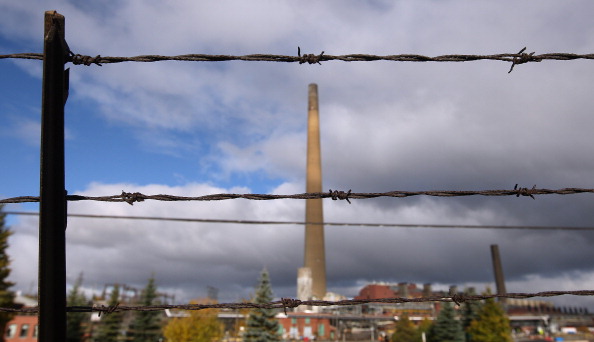
On the latest episode of the Global News podcast What happened to…? Erica Vella revisits the biggest environmental crisis of the 1980s, acid rain.
In the 1980s, the threat of acid rain in Canada and the U.S. had become a brewing environmental crisis.
In areas of Southern Ontario, lakes that once were teeming with wildlife were on the verge of becoming dead lakes, void of fish and other aquatic species.
Acid rain occurs when sulphur dioxide and other pollutants mix with moisture in the air to form rain droplets with a high level of acidity. This acidity causes aluminum to leach out of the soil and water, potentially poisoning the plants and animals in the impacted ecosystem.
Michael Perley said he recalls one trip Killarney Provincial Park when he was in his 20s.
“We came across a couple of those bowl-shaped lakes,” he said.
“They were remarkably clear. … At 15, 20, 25-feet deep, you could see the bottom. There was nothing in the water. There were no fish, there were no snakes. There was nothing, no minnows. It was just a clear blue. It looked like a swimming pool. And I was really struck by this.
“It was beautiful, but it was eerie and unusual, very unusual.”
Perley said this would be one of his first introductions to the effects of acid rain and it would be an issue that would change the course of his career years later. He would go on to work with the Canadian Coalition on Acid Rain to inform the public about its harmful impacts and lobby for environmental change in both Canada and the U.S.
“I had an interest in that at a visceral level because it was happening in places that I was familiar with and loved, … lakes and rivers,” Perley said.
Acid rain had been a big issue in Sudbury because of its nickel production.
“The sulphur is driven off into the atmosphere as a waste product and that sulphur then leads to acid rain,” explained John Gunn, a professor and the Canada Research Chair in Stressed Aquatic Systems at Laurentian University.
“Because this was such a big industry here and we had such enormous smelters operating here to do the processing of copper and nickel, we became notorious in the world as being the largest source of sulphur-generating acid rain in the world.”
- Ford government’s Bill 124 backpay cost increases again, closing in on $7B
- Ontario city cracking down on ‘slum’ landlords who ‘ruin neighbourhoods’
- Ontario ends 2023-24 with nearly balanced budget, partly due to international tuition
- 1st-degree murder charges laid after 2 people shot dead at Keswick, Ont. park
Perley said early on, large smelters located in places like Sudbury were identified as a source of the pollution and all levels of government worked to change regulations and have companies reduce emissions.

Get daily National news
READ MORE: How George H.W. Bush and Brian Mulroney teamed up to curb acid rain
“It was very important that we lean on the Ontario provincial government (and) Quebec provincial government. And then, in terms of vehicle emissions, … we had to lean on the federal government in Canada to get tougher vehicle emission standards as well,” he said.
“Then there was the matter of the Canadian government recognizing the nature of the problem and how much U.S. action was essential to solving the problem in Canada.”
The acid rain crisis also led to a bilateral Canada-U.S. agreement: the Air Quality Agreement, which was signed in 1991 by former prime minister Brian Mulroney and then-U.S. president George H. W. Bush.
WATCH: Former Canadian prime minister Brian Mulroney, who served during former U.S. president George H.W. Bush’s term, delivered a tribute to his friend and spoke about his life both as president and as a citizen.

Mulroney and Bush committed to cutting down on the air pollution that causes acid rain in 1991, under the Canada-U.S. Air Quality Agreement. Both nations promised to reduce the emissions of sulphur dioxide and nitrogen oxides — the air pollutants that give rise to acid rain — through a cap-and-trade system.
“It was everything we had been asking for, and he delivered, big time,” Mulroney said of Bush in 2012.
The agreement led to major reductions in dirty fossil-fuel emissions in both countries. Canada slashed its total sulphur dioxide emissions by approximately 63 per cent from 1990 to 2014, while the U.S. cut emissions by 79 per cent. Both countries also recorded major reductions in nitrogen oxide pollution.
READ MORE: ‘He delighted in being challenged’ — Renowned ecologist David Schindler remembered
At the height of the environmental crisis, Gunn said 2.5 million tonnes of SO2 emissions were being released in the atmosphere a year from Sudbury.
Gunn put that in context to explain just how enormous that amount was.
“That’s more than all of Europe produces today. An industrial nation like Japan would produce less than a million tons (a year). So here is one city and one industry (with) two or three times more than that,” Gunn said.
READ MORE: Scientists protest federal cuts to open-air lake research facility
With changes in emission standards, Gunn said Sudbury now emits 50,000 tonnes of SO2 a year. In Canada, SO2 emissions have decreased by 69 per cent — and in Sudbury, by 98 per cent.
On this episode of Global News’ What happened to…?, Erica Vella finds out how emissions causing acid rain were reduced, what is happening now in Ontario lakes, and how can we apply the lessons learned from acid rain to other environmental problems.
— with files from Josh K. Elliott
Contact:
Email: erica.vella@globalnews.ca
If you enjoy What Happened To…? please take a minute to rate it on Apple Podcasts or Google Podcasts, tell us what you think and share the show with your friends.
If you haven’t subscribed yet — what are you waiting for?
Subscribing’s easy! Here’s how…

- Open the Apple Podcasts app, search for “What Happened To?” and select it from the list of results.
- Once on the What Happened To? page, click the “subscribe” button to have new episodes sent to your mobile device for free.
- Click the name of an episode from the list below to listen.

- Open the Spotify app, search for “What Happened To?” and select it from the list of results.
- Once on the What Happened To? page, click the “Follow” button to have new episodes sent to your mobile device for free.
- Click the name of an episode from the list below to listen.








Comments